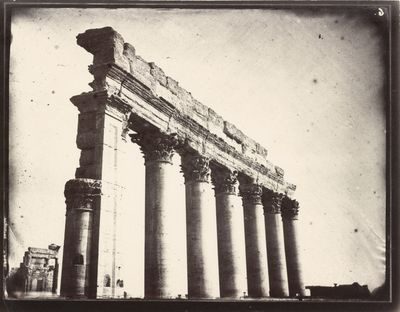For the world today, the ancient city of Palmyra may seem nothing more than just a dusty, mute victim of war. Much of Palmyra that we know is through blurry images and video footage often circulated by media and Islamic State militants after they destroyed the priceless monuments and erased cultural heritage. But the legacy of Palmyra, a UNESCO World Heritage Site, dates much before all this turmoil, and deserves to be known by a global audience. As a tribute to the legendary city, The Getty Research Institute has launched The Legacy of Ancient Palmyra, its first online exhibition featuring the institute's rare collection of photographs and illustrations that give a glimpse of the archaeological site as it stood over 150 years ago.
In what makes an unparalleled visual experience, the exhibition portrays first-ever photographs of Palmyra from 1864 and earlier drawings and etchings of the city. These visuals are weaved together with text that breaks down the history of Palmyra’s captivating past and presents an image of its modern-day peril. Adding depth, the website, through separate sections, takes you through the rise and fall of the caravan city and its architectural wonders like the Temple of Bel, Temple of Baalshamin, the iconic Arch of Triumph and Tetrapylon, each destroyed by IS. On an interactive platform, online visitors can also read about the history of these buildings and explore the city plan.
Palmyra was once a flourishing desert oasis and cosmopolitan trade hub under the Roman Empire during the 1st and 3rd centuries CE. The ancient metropolis later attracted the attention of Western scholars and travellers, who were mesmerised by Palmyra's distinctive style of architecture, blending Greco-Roman techniques with local traditions and Persian influences.
 Temple of Bel, Louis Vignes, 1864
Temple of Bel, Louis Vignes, 1864
Most of the visual content used in the exhibition are photographs by French naval officer Louis Vignes and drawings and etchings from Louis-François Cassas, a French architect and artist. Cassas was commissioned by the French ambassador in 1784 to record the monuments of Egypt, Syria, Lebanon, Cyprus, Palestine, and Asia Minor. He made more than 100 large-format etchings of Palmyra which appeared in an extensive three-volume publication of his expedition. In 1984, the Getty Research Institute acquired a collection of trial prints made after drawings that Cassas produced during his voyage. Along with this was an unpublished manuscript written by Cassas which provides detailed notes on the architectural splendours of Palmyra's tombs, temples, arches, porticoes and sculptures.
Produced more than 75 years after Cassas's etchings, photographs by Vignes complement Cassas's drawings to create a one-of-a-kind visual record. Vignes was hired by French nobleman Luynes to be part of his self-funded scientific expedition to the Dead Sea in 1864. To visually record the expedition, he got photographer Charles Nègre to train Vignes in photography. Vignes became the first to photograph the monuments, making the images displayed in the exhibition the earliest known photographic images of the ruins. Until their acquisition by the Getty Research Institute in 2015, Vignes's Palmyra photographs, printed by Nègre, were largely unknown because they had remained in the possession of the Luynes family after the nobleman's untimely death in 1867.
The Institute's venture is an attempt to bring the enduring legacy and persona of the city back into the limelight and to encourage deeper understanding of historical cities. The online exhibition, with its sepia-toned visuals, will transport you to the little-known golden era of the ancient metropolis, only to make your heart ache at the way heritage has been ruthlessly massacred.







